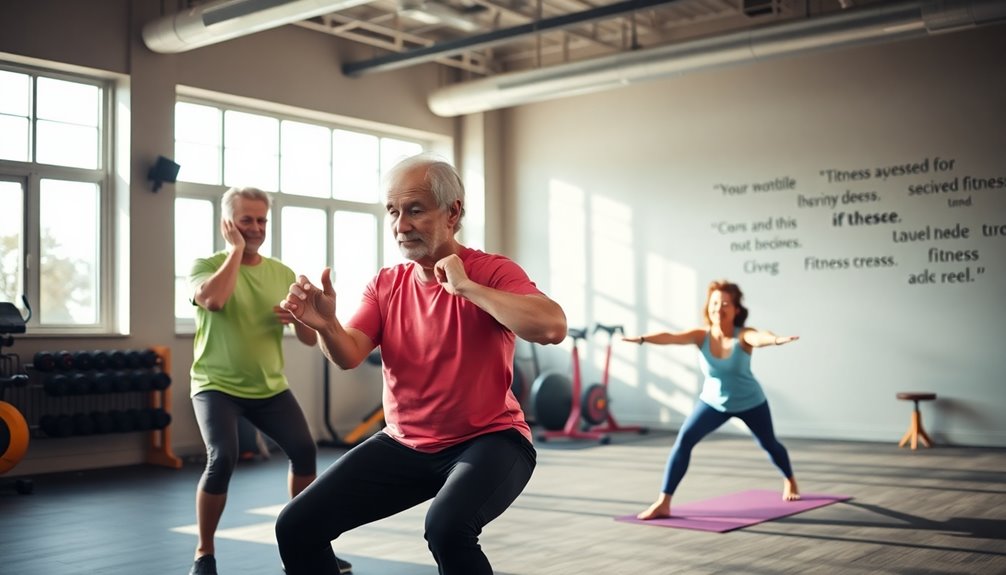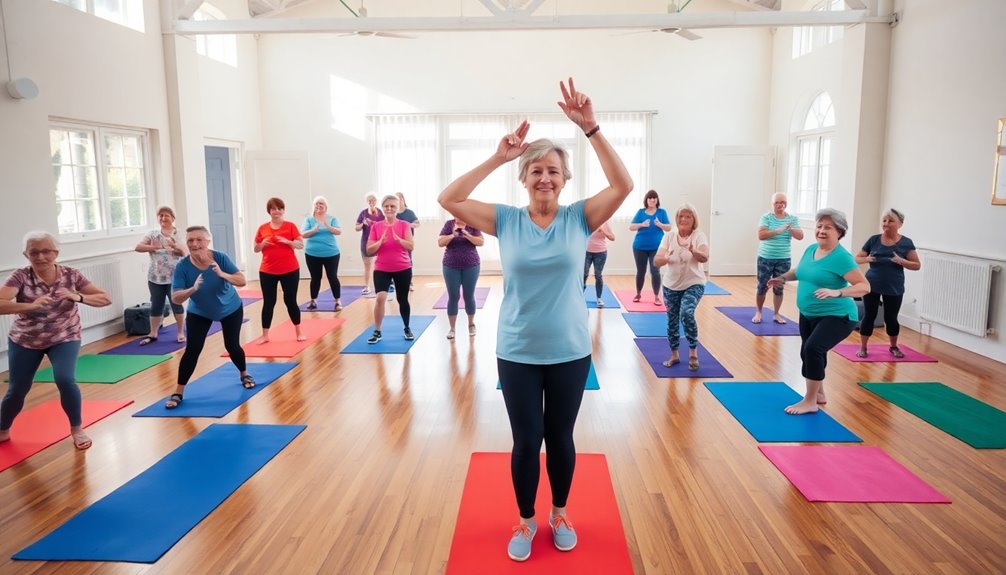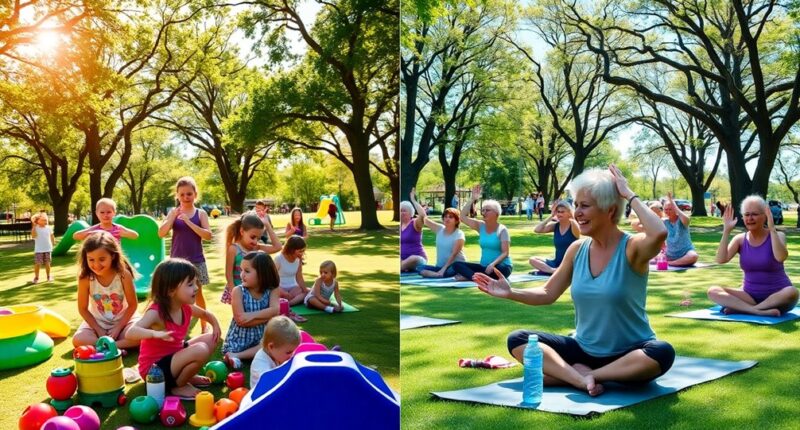Tailoring your routine for different age groups is essential for maintaining health and fitness. Young adults should focus on strength training and high-intensity workouts, while middle-aged individuals need to adjust to resistance training and moderate-intensity exercises to protect against muscle loss. For older adults, functional fitness and low-impact activities enhance balance and coordination. Nutrition and sleep also play significant roles at each stage. Keep going to uncover more about the benefits of age-specific exercise and nutrition!
Key Takeaways
- Young adults (20-35) should focus on strength training and high-intensity workouts to build muscle and cardiovascular fitness.
- Middle-aged adults (36-55) require resistance training and mobility exercises to maintain muscle mass and flexibility, along with moderate aerobic activity.
- Older adults (55+) should prioritize functional fitness, low-impact cardio, and exercises that enhance balance and coordination for overall well-being.
- Nutritional needs vary by age; young adults need higher protein, while middle-aged individuals should focus on antioxidants, and older adults require hydration and calcium.
- Incorporating community-based fitness programs can foster social connections and improve mental health across all age groups.
Understanding the Importance of Age-Specific Routines

Understanding the importance of age-specific routines is essential, especially since your body's needs change as you grow older.
Tailored workouts are vital for each life stage to address different fitness goals. For older adults, focusing on functional movements helps maintain independence and prevent falls, while also accommodating hormonal changes that can affect strength and balance.
Regular exercise not only aids in maintaining muscle mass but also enhances your overall fitness experience.
In addition, incorporating low-impact exercises supports mental health by reducing stress and improving cognitive function. Furthermore, ensuring proper nutrition is crucial for overall health, as it supports brain development and emotional well-being.
Fitness Guidelines for Young Adults (20-35)

As you navigate your twenties and thirties, establishing a solid fitness routine becomes essential for long-term health and wellness.
Aim for strength training at least 3-5 days a week, focusing on compound exercises like squats and deadlifts to promote muscle growth and enhance overall health.
Incorporate high-intensity interval training (HIIT) 2-3 days a week to boost cardiovascular fitness and metabolic efficiency.
Don't forget flexibility routines, such as yoga or stretching, to maintain mobility and prevent injuries.
Pay attention to nutrition, ensuring your protein intake is around 1.6-2.2 grams per kilogram of body weight for ideal recovery.
Additionally, consider incorporating hula hooping into your routine, as it can be a fun way to burn calories and engage your core muscles.
Finally, prioritize adequate sleep, ideally 7-9 hours each night, to support muscle repair and maintain a healthy weight.
Adjusting Workouts for Middle-Aged Adults (36-55)

Establishing a solid fitness routine in your twenties and thirties sets the foundation for a healthy lifestyle, but as you reach your mid-thirties and beyond, it's time to adjust your approach.
Focus on maintaining lean muscle mass through resistance training 2-3 times a week. This combats the natural slowdown in metabolism. Incorporate high-impact activities like running or circuit training to boost your cardiovascular health, alongside mobility exercises such as yoga or Pilates to enhance flexibility.
Nutrition also plays a key role; aim for 1.0-1.5 grams of protein per kilogram of body weight to support muscle maintenance. Additionally, incorporating anti-inflammatory foods like turmeric's potent relief can help manage joint pain as you age.
Aim for at least 150 minutes of moderate-intensity exercise weekly to promote overall health and well-being.
Emphasizing Functional Fitness for Older Adults (55+)

As you age, focusing on functional fitness can greatly enhance your balance and coordination, making daily activities easier and safer.
Incorporating low-impact cardio options and strength training into your routine helps maintain muscle mass and improve overall stability.
This approach not only supports your physical health but also boosts your confidence and independence.
Enhancing Balance and Coordination
To maintain independence and prevent falls, enhancing balance and coordination is essential for older adults. Engaging in specific exercises can greatly reduce the risk of falls by improving stability and proprioception.
Here are three effective exercises you can try:
- Tai Chi: This gentle movement practice enhances balance and coordination while promoting relaxation.
- Stability Ball Workouts: Using a stability ball strengthens core muscles, contributing to better overall mobility.
- Seated Leg Lifts: These help build core strength and improve balance, making daily activities easier.
Participating in community-based fitness programs focusing on balance not only enhances physical health but also fosters social connections, boosting mental well-being. Additionally, creating cozy spaces that are safe and accessible can encourage regular exercise at home.
Prioritize these exercises to enjoy a safer, more independent lifestyle.
Low-Impact Cardio Options
While maintaining a regular exercise routine can seem challenging, low-impact cardio options offer an accessible way to enhance your cardiovascular health without putting undue stress on your joints.
For older adults, activities like walking, swimming, and cycling can help maintain cardiovascular health and reduce the risk of injury. Aim for at least 150 minutes of these exercises each week.
Incorporating Tai Chi or water aerobics not only boosts endurance but also supports functional fitness by improving balance, flexibility, and muscle strength.
Don't forget to include at least two days of muscle-strengthening activities for overall well-being.
Consistent low-impact cardio can also aid in weight management, allowing you to engage more actively in your daily routines and social interactions. Additionally, embracing a mindset of self-acceptance in the aging process can greatly enhance the enjoyment and effectiveness of your fitness routine.
Strength Training Benefits
Building on the foundation of low-impact cardio, strength training offers remarkable benefits for older adults aged 55 and up. Engaging in strength training 2-3 times a week can greatly enhance your functional fitness, allowing you to tackle daily activities with ease.
Here are three key benefits:
- Preserves lean muscle mass: Counteract age-related muscle loss to maintain metabolic function.
- Improves balance and stability: Reduce the risk of falls by enhancing coordination and overall stability.
- Boosts bone density: Strength training helps prevent osteoporosis, essential for avoiding fractures as you age.
Additionally, it supports mental health, reducing symptoms of anxiety and depression. Engaging in strength training can also help combat the physical effects of narcissistic abuse, promoting overall well-being and resilience.
Embrace strength training to enjoy a healthier, more independent lifestyle!
Nutrition Considerations Across Life Stages

Understanding your nutritional needs at different life stages is key to maintaining health and vigor. In young adulthood, you'll focus on higher protein intake for muscle support, while middle age calls for antioxidants to protect against disease. As you get older, staying hydrated and ensuring adequate calcium and Vitamin D becomes essential for overall well-being. Additionally, incorporating HEPA filtration into your living environment can help improve air quality and support respiratory health at any age.
Protein Needs by Age
As you navigate different life stages, it's essential to recognize that your protein needs vary considerably.
Here's a quick guide on protein needs by age:
- Children and adolescents: Aim for 1.0-1.5 grams of protein per kilogram of body weight to support growth and active lifestyles.
- Young adults (18-35 years): Target 1.6-2.2 grams to promote muscle gain and recovery, especially with regular strength training.
- Middle age and older adults (55+ years): Maintain 1.0-1.5 grams to counter age-related muscle loss and support overall health.
Adequate protein intake across these stages is essential for repairing tissues, producing enzymes, and maintaining a healthy immune system. Additionally, AI jobs in nutrition and health technology are emerging as a field that combines dietary knowledge with data analysis to enhance wellness.
Prioritize animal sources for complete proteins and enjoy the benefits throughout your life!
Hydration Importance Throughout Life
Hydration plays an essential role in maintaining your health at every stage of life, especially since your body's water needs change as you age.
Young adults typically require around 3.7 liters for men and 2.7 liters for women daily, while older adults often need more due to a reduced sense of thirst.
Keep in mind that dehydration can lead to serious health issues, including kidney stones and urinary tract infections.
Infants and children have higher fluid needs relative to their weight, making hydration vital during hot weather or physical activity.
Chronic dehydration can contribute to fatigue, cognitive decline, and skin issues, reinforcing the need for consistent hydration practices throughout all life stages to meet your unique fluid needs. Additionally, understanding hydration needs during different life stages can help in planning appropriate fluid intake strategies.
Antioxidants for Disease Prevention
Antioxidants are essential for disease prevention at every stage of life, offering protection against oxidative stress that can lead to chronic health issues.
By incorporating antioxidants into your diet, you can greatly enhance your overall health and longevity. Here are three key benefits:
- Childhood and Adolescence: Boosts immune function and cognitive performance through vitamins C and E found in fruits and vegetables.
- Middle Age: Reduces the risk of age-related diseases like heart disease and cancer by consuming antioxidant-rich foods such as berries and leafy greens.
- Older Adults: Alleviates inflammation and oxidative damage, potentially preventing cognitive decline and conditions like Alzheimer's.
Incorporating chia seeds into meals can further enhance the antioxidant benefits due to their high omega-3 content.
Prioritize those antioxidant-packed fruits and vegetables daily to safeguard your health through the years!
Recovery and Sleep Needs for Different Ages

Recovery and sleep needs vary considerably across different age groups, reflecting changes in the body's physiology and lifestyle. For older adults, focusing on restorative sleep is vital for supporting recovery and mental clarity. You should aim for 7-8 hours of quality sleep, as sleep disturbances can affect your rest. Incorporating gentle stretching and mobility exercises helps maintain joint health and functionality, making recovery smoother.
| Age Group | Recovery Strategies |
|---|---|
| Younger Adults | Intense workouts, quick recovery |
| Middle-Aged | Balanced routines, hydration |
| Older Adults | Gentle stretching, adequate sleep |
Staying hydrated is essential too, as the sense of thirst diminishes with age. Prioritize your recovery to enhance your overall well-being!
Risks and Diseases Associated With Aging

As you age, you're increasingly at risk for various diseases and health conditions that can greatly impact your quality of life. Recognizing these risks is essential for maintaining independence and long-term health.
Here are three common issues to be aware of:
- Osteoporosis: About 1 in 3 women and 1 in 5 men face fractures due to decreased bone density.
- Heart Disease: It remains the leading cause of death in older adults, with nearly 697,000 deaths in 2020 alone.
- Arthritis: Affects nearly 60 million Americans, causing joint pain and mobility issues.
Additionally, cognitive decline and diabetes are growing concerns.
Incorporating targeted fitness routines can help mitigate these risks and promote a healthier aging process.
Mental Health Benefits of Staying Active

Staying active isn't just about physical health; it plays an important role in your mental well-being too. Every time you engage in exercise, you boost your emotional well-being by releasing endorphins, those "feel-good" hormones.
Just 30 minutes of moderate physical activity most days can greatly enhance your mental health. Regular fitness is linked to lower anxiety and depression levels, improving cognitive function and reducing the risk of cognitive decline.
Plus, the social interactions you gain through group exercises help combat loneliness, providing essential emotional support. Maintaining an active lifestyle also aids in stress management by lowering stress hormones like adrenaline and cortisol.
Seeking Professional Guidance for Tailored Fitness Plans

How can you guarantee your fitness routine is effective and safe? By seeking professional guidance from certified trainers, you can ascertain your tailored fitness plans meet your individual needs.
Here's how they can help:
- Fitness Assessments: Trainers evaluate your cardiovascular fitness, strength, flexibility, and body composition, providing personalized insights for your workout plans.
- Modifications for Exercises: They offer tailored modifications, especially important for older adults or those with specific health conditions, ascertaining safety and inclusivity.
- Accountability and Progress Tracking: Regular consultations keep you motivated and allow for adjustments to your plans as you progress, ascertaining continued improvement.
Engaging with a trainer not only enhances your routine's effectiveness but also fosters long-term adherence and health benefits.
Frequently Asked Questions
How to Change Your Fitness Routine as You Age?
As you age, you need to adjust your fitness routine to meet your changing body's needs.
Start by incorporating strength training and high-intensity workouts in your younger years.
As you evolve, shift to resistance training and low-impact cardio to protect your joints.
In later years, focus on functional exercises and flexibility to maintain mobility.
Don't forget to prioritize recovery; it becomes essential for preventing injuries and ensuring you stay active and healthy.
What Are the Exercise Guidelines of Who for Different Age Groups?
So, you think sitting on the couch counts as exercise? Think again! The WHO's got you covered with some solid guidelines.
If you're 5-17, aim for 60 minutes of activity daily.
For adults 18-64, shoot for 150 minutes of moderate aerobic activity weekly, plus strength training.
If you're 65 and older, balance and strength training three times a week is key.
And don't forget to break up those long sitting sessions!
Conclusion
Incorporating age-specific routines isn't just smart; it's essential for your well-being. By tailoring your fitness, nutrition, and recovery strategies to your life stage, you're not just surviving—you're thriving. Imagine the energy you'll feel and the health benefits you'll gain as you embrace this personalized approach. So, why wait? Take charge of your routine today, and watch how it transforms not just your body, but your entire life. The best time to start is now!









